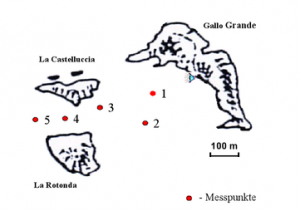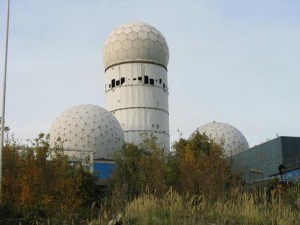From (aural) memory, I recollect a selection of events which inspired the latest session of Hearing Modernity, all of them reconstructions of a sonic past in one way or another.

Bijsterveld’s presentation opened with a photograph of Erich Mielke’s desk. (source: http://www.stasimuseum.de/ausstellung.htm)
Maastricht, 2013: Historian and Professor of Science, Technology & Modern Culture Karin Bijsterveld receives a package of over a thousand pages from the Stasi archives in Berlin, documenting “the lives of others,” that is the lives of individuals whom the Stasi subjected to surveillance (wire-tapping) between 1965 and 1989. But the files also give insights into the lives and the work of the Stasi officers behind the tape recorders and telephone lines whose job it was to retrieve relevant information from suspect phone calls as well as all the locations they had previously bugged. In their effort to employ this sonic data for forensic purposes, the main challenges that the Stasi faced lay in the realm of voice recognition—a program by no means unique to the GDR—as well as the definition of an archival classification system for a voice data bank. With both of these concerns, Bijsterveld shows that the Stasi’s approaches were in line with scientific paradigms of the time but ultimately proved unsuccessful. While the hopes set on sonograms as visual representations of voice-prints were dashed by their lack of reliability, the documentation and description of the officers’ listening analyses required ever more complex systems of knowledge organization. In the context of a totalitarian agenda, and in light of the overwhelming amount of incoming data, such organized methods of transcription were essential in retaining (the pretense of) efficiency. Apart from apparently deeming verbal descriptions more efficiently accessible than storing the voice recordings themselves, financial constraints compelled the Stasi to reuse (and thus delete) most of their recording tapes, as Wolfgang Ernst added to the discussion during the seminar session. What is left, therefore, are written accounts of sonic events, subjective descriptions in a totalitarian objectifying system, shielded moreover by the archive’s protective regulation of user access today.
While Bijsterveld’s study reconstructed a narrative from selected accounts from the ears of Stasi officers, Wolfgang Ernst invoked an experience in which he relied on his own media-archeological ears to test, in the present, a phenomenon from the much more distant past.

Map of the Li Galli islands from the experimental set-up of the expedition; the red dots indicate points where acoustic measurements were taken, the speaker symbol shows the placement of the sound sources. (source: https://www.medientheorien.hu-berlin.de/forschung/projekte/sirenen)
To follow Ernst we have to imagine a change of scenery: On a boat in the Mediterranean, between the Amalfi coast and the offshore Li Galli islands, 2004. The éminence grise of German media theory, Friedrich Kittler, and an interdisciplinary team of researchers, among them philologist and media theorist Wolfgang Ernst, are on an ambitious expedition to recreate the sound of the sirens that imperiled Odysseus’s journey home. Kittler is convinced that the famous sirens episode took place at Li Galli and is determined to put this to the test. Positioned on the islands are two operatic sopranos, as well as a pair of mechanical sirens (following Helmholtz’s model of the double siren), emitting sounds into nature to test the acoustic properties of the surrounding environment. (Kittler and his team settled on two singers, since the sirens episode uses the grammatical form of the dual, common in Homeric Greek, which always indicates two speakers.) The implications of the experiment’s findings go well beyond establishing the veracity of Homer’s epic and the possible nature of the sirens’ song. All of its concerns coalesce in the Ancient Greek alphabet, which was used for writing down words and numbers as well as for notating music. As the first written alphabet that had letters for vowels (as well as for consonants), the Greek alphabet not only lent itself to capturing the song of the sirens (as part of the Odyssey) but to sounds more generally, allowing them to be stored and reproduced. Indeed, for a media-archeological project such as Ernst advocates it, such a re-translation of the symbolically signified into the sonically real is of crucial importance, since it is only through the fleeting auditory experience in time that we can establish a sense of space, as Bergson has argued. In a similar vein, Ernst proposes a consideration of the sonic as a new form of memory, involving a technologically attuned way of listening, indeed listening to and in modernity. Ultimately, he emphasizes, sound – whether heard, recorded, or transmitted – “is radically ahistorical,” making it a subject to archeology rather than history (p. 10). As such, sound also defies common conceptions of archiving – “as opposed to the archival order of musical notation” (p. 14), the latter of which can be drawn on for practices of “inner listening” in an Adornian sense. While recording technologies might offer ways for encoding, storing, processing, and reproducing sounds, Ernst reminds us of their inherent entropy, occurring in divergent forms in mechanical, electro-magnetic, and digital technologies, highlighting also that each of them brings about specific epistemological implications.
This brings us to today, anywhere around the world, but emblematically to Berlin (again), a junction not only to the topics discussed but also to pressing concerns emanating from them. Recent exposure of comprehensive trans-national surveillance practices has provoked heightened sensitivity among citizens across continents on the lacking protection of privacy and has given rise to a vigorous discussion on the (im)possibility of granting such rights and safeguarding data streams. In this context, Bijsterveld’s work sadly gains acute topicality, even though her concluding findings gave reason to hope. As it turned out, the self-controlling mechanisms implemented by the totalitarian system were not meticulous enough to prevent the GDR from maintaining several coexisting voice data banks in different political divisions, under divergent classification systems, and – crucially – for a long time without each other’s awareness. Wolfgang Ernst, however, refocuses the discourse in the presence, pointing to the changed technological possibilities for the collection and assessment of data that come with digitization. These technologies might of course meet their own challenges, either in comparable instances of internal miscommunication, or systemic failure. Maybe then, we could find consolation in an admonitory monument from the past, reminding us of the intrinsic impermanence of recording technologies and their resulting historical contingency.

Berlin: abandoned U.S. spy station on Teufelsberg (“Devil’s Mountain”), brought to the discussion by respondent Peter McMurray – see his post on the soundblog. (source: www.berlin.de/tourismus/fotos/sehenswuerdigkeiten/1656750-1355138)
In the present our journey ends (for now), having traveled through history, accompanied by sounds long gone.




Leave a Reply